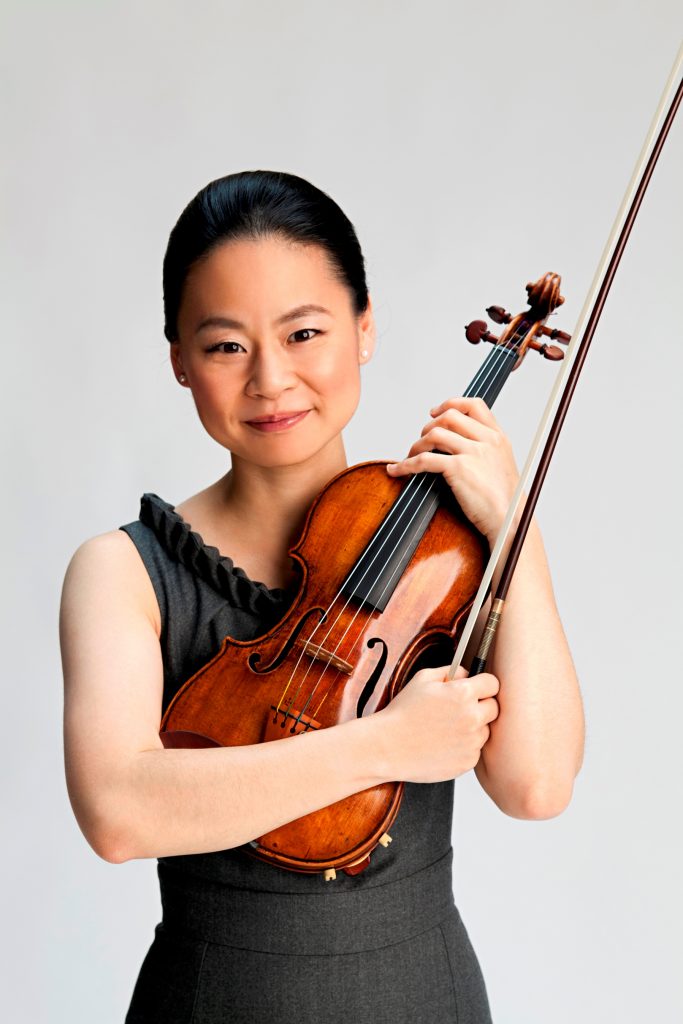Midori and Macdonald Triumph in the Tchaikovsky Violin Concerto
It is amazing how a single performer can transform your perception of a work you know well. Take Tchaikovsky’s popular and over-programmed Violin Concerto, which headlined the San Diego Symphony’s Friday (April 1) program at Copley Symphony Hall. When I see this Violin Concerto listed on an upcoming program, I find it difficult to work up enthusiasm to hear this warhorse again, even when a soloist the caliber of Midori is promised.
According to the program book, Midori is the 20th violinist to perform the Tchaikovsky Violin Concerto with the local orchestra since the sainted Nicolai Sokoloff introduced it to San Diego Symphony audiences in the summer of 1941. It is arguably the most popular violin concerto in the repertory, and San Diego apparently cannot get enough of it.Because Midori did not approach the concerto as the big Romantic warhorse nearly everyone imagines it to be, she allowed the more classical proportions of Tchaikovsky’s violin part to shine with a Mozartean clarity and precision, without sacrificing for a moment that passionate drive that propels the concerto. From Midori’s ecstatically hushed tones and diamond bright figures in the opening cadenza, to her mesmerizing reverie of the second movement’s folk-like theme, to the finale’s immaculately disciplined verve, Midori both owned and redefined the work.
She was assisted at every turn by guest conductor Rory Macdonald, who sagely calibrated the orchestra’s dynamics to support but never overshadow the soloist. And when she was not playing, he encouraged the orchestra to bloom with added color and muscle, eliciting some of the most unified and sonically alluring playing—especially from the brass choirs—that I have heard all season. I found Macdonald’s conducting authoritative and cleanly defined, executed in an ingratiating collegial fashion. From the orchestra’s response, I would say they liked what they saw.With the eager assent of the orchestra, Macdonald gave a robust, sympathetic account of Serge Rachmaninoff’s final opus, the “Symphonic Dances.” In spite of Rachmaninoff’s masterful orchestration, his themes tend to glide all too easily on the surface. At times, notably the first movement section that features the piano, strings and harp, it sounds more like a Hollywood motion picture score from the 1930s. Bartók’s “Concerto for Orchestra,” completed three years after the 1940 “Symphonic Variations,” it is not.
Macdonald chose a suitably brusque opening tempo for the work, reminding us that its driving motor rhythms owe something to the symphonic style of the composer’s fellow countryman Sergei Prokofiev, and he was not afraid to indulge the rapturous sweep of the composer’s grand Romantic themes that were his calling card.
To open the program, Macdonald chose a Dvořák rarity, his short tone poem called “Midday Witch,” a Czech folk tale set in rather literal but mildly charming orchestral writing. This piece demonstrated why orchestras love Dvořák’s symphonies, but when it comes to choosing a tone poem, Richard Strauss gets the vote almost every time.
[themify_box style=”shadow” ]This concert by the San Diego Symphony was given on April 1, 2016, at the Jacobs Music Center’s Copley Symphony Hall. It was repeated on April 2 & 3, 2016, in the same venue.[/themify_box]
Symphony with Midori program and bios

Ken Herman, a classically trained pianist and organist, has covered music for the San Diego Union, the Los Angeles Times’ San Diego Edition, and for sandiego.com. He has won numerous awards, including first place for Live Performance and Opera Reviews in the 2017, the 2018, and the 2019 Excellence in Journalism Awards competition held by the San Diego Press Club. A Chicago native, he came to San Diego to pursue a graduate degree and stayed.Read more…


![Rory Macdonald [photo (c) Benjamin Elovega]](http://www.sandiegostory.com/wp-content/uploads/2016/04/Rory-Macdonald2_BenjaminEalovega-1024x683.jpg)


You are so right!